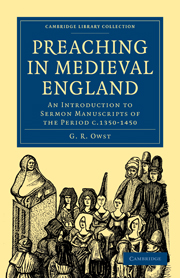CHAP. I - “BISHOPS AND CURATES”
Published online by Cambridge University Press: 07 September 2010
Summary
“Who can lawfully preach?” is a typical question put by the Regimen Animarum, one of the little hand-books of Canon Law and instruction so plentifully furnished for mediaeval clergy in the fourteenth and fifteenth centuries. The answer is not quite so simple as might be expected, though the main principle underlying it is sufficiently clear and accredited. “Priests, deacons and subdeacons, if they have preferment and the care of souls (si habeant prelationem et curam animarum), because those so entitled preach by reason of their preferment, not by reason of their order.”
“Ratione prelationis,” this then determines the Church's prime choice of the men called to be her regular spokesmen in the pulpit, the bishop and the “curate” or beneficed parson, who have the authoritative charge of souls. The rest of that vast preaching host of the later middle ages, monks and Mendicants, University graduates in theology, vicars, chaplains, pardoners and recluses, even the Templar and Hospitaller, and the rest, are but auxiliaries, to be admitted to the ranks of sacred heraldry only by special privilege, and further license by their own prelati, and those of the places where they might preach. Yet, as the world knows, it was the auxiliary, in this as in other developments in the history of the Church, who was destined to play by far the most conspicuous part. From the point of view of preaching, the mediaeval prelatus, whether as dignitary or merely a humble parish priest, might well be expected to plead before long that that sacred duty must of necessity be shared with others less burdened than himself.
- Type
- Chapter
- Information
- Preaching in Medieval EnglandAn Introduction to Sermon Manuscripts of the Period c.1350–1450, pp. 1 - 47Publisher: Cambridge University PressPrint publication year: 2010First published in: 1926



